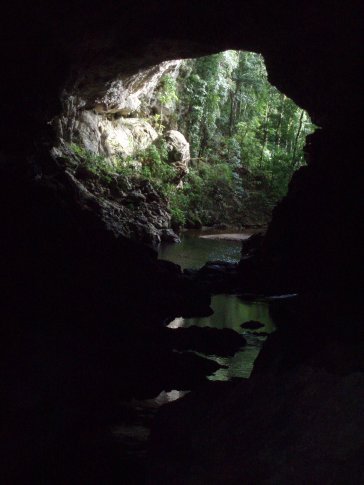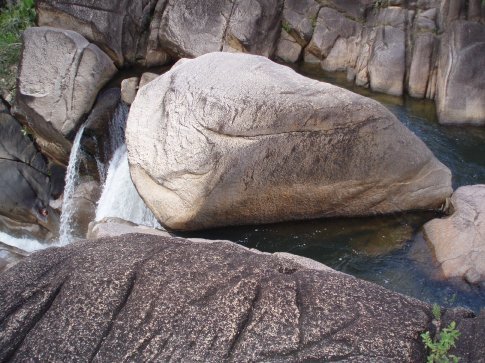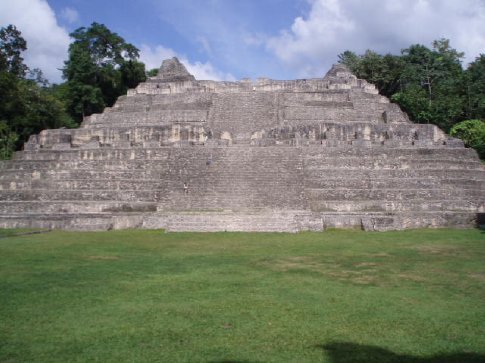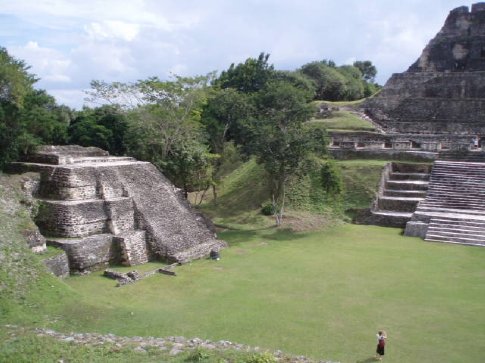After the backwater horror of Belmopan, we were pleasantly surprised by San Ignacio – Belize´s third biggest town. Its gets a lot of tourist activity, as its near a handful of Mayan sites, including Tikal, across the border in Guatemala. Its also next door to the Mountain Pine Ridge Reserve (the largest area of Caribbean Pine in Central America), various caves with Mayan artefacts and a lot of outdoor pursuits including rappelling and cave tubing. Anyway, the place is packed full of nice guest houses and decent restaurants. Of particular note were three restaurants that specialised in Indian food. Oh yes! Guess where we spent all our evenings.
San Ignacio is really a ´tour town´ – there´s only a handful of things you can get to yourself without a car, so we duly did the rounds and booked ourselves in with various companies. Our first trip was through the Mountain Pine Ridge reserve to the ancient Mayan city of Caracol. Caribbean pines thrive here, as the sandy, poor soil allows them to outcompete the usual tropical trees that predominate in most of the rest of C.A. I guess once a layer of pine needles has built up, acidifying the soil further, the effect is self-reinforcing too.

Looking through the Rio Frio Cavern
However, a few years ago a pine beetle infestation swept through and killed 90% of the trees (someone´s really got it in for Belize´s forests). The reserve is recovering now, but the result is that most of the landscape is covered in low, young pine growth, coming up through blasted dead trunks. Just before the Caracol reserve, we crossed a large river – on one side was pine, on the other tropical moist forest – the river runs down the join between sandstone and limestone bedrock- quite surreal.
The reserve is also host to a number of caves and waterfalls. We visited the Rio Frio cavern, a huge natural tunnel through a hill, and on the way back from Caracol, the Rio Falls – a beautiful set of little falls, pools and natural waterslides. We spend a fun few hours clambering around – although we were shown up badly by a set of kids (including a four year old!) who repeatedly jumped fearlessly down one of the dodgier-looking (in our eyes) slides. Eh well. Maybe we´ve still got some way to go in challenging our boundaries. Either that, or we´ve reached our mid-thirties because we didn´t dive headlong down rocky slides – yeah! That’s what it is, its a natural selection thang.

Beautiful pools and flumes at the Rio Frio Falls
After two hours of bumpy track we arrived at Caracol. The city is Belize´s largest Mayan ruin – it covers an area of 30 square miles, with over 35,000 buildings identified. It´s estimated that it supported over 200,000 people in its heyday. To put that in perspective, the present-day population of the whole of Belize is only 300,000 people. Now dense forest covers it all. Like at most sites, most of the main plazas have now been excavated and consolidated.
Caana, the largest pyramid on the site, is still the largest building in Belize! (and the second biggest in the Mayan world). As at a lot of the sites, we were blown away by the shear scale of the temples – Canna is a medium-sized hill, with views for miles over the forests of the Maya Mountains and Guatemala. Stucco friezes of the sun god glare out at you from across the plaza. The site is so remote that it was only rediscovered by loggers in the 1930´s, and its true scale only came to light when it was investigated by archaeologists the 1980´s.

Caana. There´s another plaza and three more mini-temples built on top of this one that you can´t see from here....
The next day we took ourselves on the chicken bus to the more modest site of Xunantunich, just to the west of San Ignacio. The site is accessed via a hand-cranked ferry across the river. Huge Iguanas stare at you from the vegetation, and get the hell out if you approach too near (besides eating Agouti´s, the Belizeans also have a taste for Iguana – tastes like…. chicken, apparently, which makes me wonder why they bother). The major temple at Xunantunich, ´El Castillo´ also has some impressive stucco friezes that once encircled the whole structure – it gave us a much better feel for how they would have looked when in use – together with hints of the dyes they used to paint the whole structure with. The top of the temple was open so that all the population (for miles around) could see the ceremonies that the priests and lord did at the top to ensure favourable rains.

Main temple plaza, Xunantunich
On our final day we booked with a tour to go cave tubing on the Caves-Branch River. This area is in the limestone, so the karst is filled with rivers that flow partly under and over the surface. The living caves were an important part of Mayan theology – they were the entrance to the underworld where all ancestors went when they died. Very many of the caves so far explored are littered with Mayan offerings of pots and unfortunately, sometimes sacrificial victims.
Once we arrived at the river, we walked up it and then through forest until we came to a collapsed piece of tunnel that allowed access into the water. From there on it was very like our other inner-tubing experiences in C.A, except of course it was done in the pitch black, surrounded by stalactites, your helmet torch illuminating parts of the tunnel wall, whilst the light of the entrance slowly receded behind you. Various shallow rapids had to be navigated – bums up! Half way down the second cave the sound of rushing water gradually increased, until it surrounded us - it seemed we were about to go over a waterfall – but no, we floated out into a broad cave, where one side had collapsed to allow green jungle-filtered light in – the noise was the rapids of a tributary joining the river.
Finally, we floated out into the daylight – a very surreal trip. We learnt that when cruise ships came into Belize city, hundreds of people in tubes would be on the river. We were once again glad of the global downturn – less other tourists, less cruise ships, more fun for us! (although not so much fun for countries like Belize that rely on tourism for much of their foreign income).
For more photos of Mountain Pine Ridge, Caracol and Xunantunich, click here.